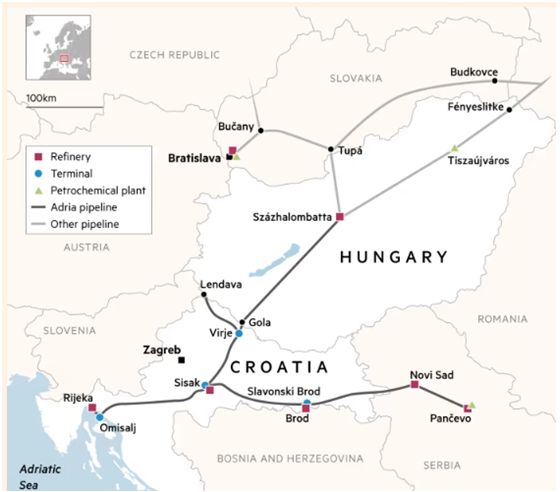Zagreb is working on plans that could double the capacity of the Adria oil pipeline to 2mn tonnes a month. That would be a lifeline for fellow EU member states Hungary, Slovakia and Slovenia as well as Serbia and Bosnia, which have terminals and refineries that connect to the pipeline and are trying to reduce dependence on Russian gas.
It is also increasing its capacity to import liquefied natural gas from the current 2.9bn cubic metres a year to 6.1 bcm/y, while a massive investment cycle in wind and solar power will allow it to become a net energy exporter, analysts said.
“Croatia has a good chance to be the energy gateway for a number of neighbouring central European countries in the current energy geopolitical situation and difficulties of energy imports from Russia,” said Igor Dekanić, a professor at the geology and mining faculty of Zagreb university.
Croatia had begun to diversify its energy sources long before Moscow’s invasion of Ukraine, importing a growing amount of oil from Azerbaijan and Kazakhstan while reducing oil flows from Russia to just over a quarter of its total imports in 2020, the lowest level since 2003.
Its regasification unit at the port of Omišalj strengthened Croatia’s independence from Russian gas, which was already less than 1 per cent of its total energy consumption by 2020, according to the IMF. Imports of LNG, mainly from the US, have replaced Russian supplies.

Now Zagreb stands to profit from becoming a larger supplier of neighbours forced to diversify their energy imports, collecting increased oil and LNG transshipment fees.
Hungary, Croatia’s north-eastern neighbour, is also strengthening its Adriatic energy links. Budapest-based energy group MOL has depended on the Druzhba (Friendship) pipeline that pumps Russian crude across Ukraine to supply its refineries near Budapest and Bratislava. That model is now threatened by EU sanctions, possible war damage or a Russian decision to halt flows, as Moscow did with gas via the Nord Stream pipeline.
The EU exempted piped crude from a ban on Russian oil announced in May which comes into force in December, and recently announced plans for a cap on Russian oil. Supply was disrupted via Druzhba in August, another reminder for countries in southern and eastern Europe to hasten contingency planning.
MOL’s fallback option was the Adria pipeline, which begins at Omišalj. It may finally help Budapest reduce dependence on Russian oil, a plan it first hatched with Yugoslavia when the discussions over a regional pipeline started in the 1960s. MOL is also preparing an upgrade of its refineries, at a possible cost of €500mn, so they can process lighter, non-Russian blends of crude.
“Refineries always operate on worst-case scenarios,” said a MOL executive. “We have no shades of grey. If we can imagine something we have to prepare for it.”
The Adria pipeline, operated by Croatian company Janaf, can transport about 1mn tonnes a month of oil. Planned additional investment to double the capacity would cover the needs of refineries in Hungary, Slovakia and Serbia, it said.
“This type of decision should be made . . . in line with the official energy policies of the EU and the Croatian government,” the company said. “Janaf is prepared to act swiftly once the decision is made.”
Hungary and Serbia last week said they would build a branch connecting to the Druzhba pipeline to ensure Belgrade continues to receive cheaper Russian crude.
Janaf has increased its prices to pump crude to neighbours, said people familiar with the matter. The majority state-owned company declined to answer detailed questions from the Financial Times, citing unspecified business obligations.
The increase in LNG import capacity at Omišalj to more than twice Croatia’s annual consumption should boost Zagreb’s regional role. “This will . . . truly make Croatia a regional energy hub,” Prime Minister Andrej Plenković said last month.
Croatia could have already assumed a much bigger role as a regional oil and gas import hub had it not delayed and scaled back the construction of its LNG terminal for a decade, said András Simonyi, an energy expert at the Atlantic Council’s Global Energy Center.
“The Croats are very late,” Simonyi said. “The US is going to ramp up LNG production rapidly . . . the EU has also accepted gas as a transition fuel. So there will be gas. But will there be infrastructure in Europe? Nobody will wait for Croatia, which could move a lot more gas with bigger ambitions.”
But Zagreb’s measured approach, betting on a short-term resurgence in demand for fossil fuels while retaining a focus on investments in green energy, may yet pay off.
With its long Adriatic coastline, Croatia is eyeing rapid development of solar and wind power, says DraženJakšić, director of Zagreb’s HrvojePožar Energy Institute. There is strong investor interest in backing new projects that would greatly increase Croatia’s current clean power generating capacity of just over 1GW, he added.
JulijeDomac, an adviser on energy to President Zoran Milanović, said the government is targeting an expansion in solar power capacity to 7GW from 160MW, and a doubling in wind power from the current 1GW, and working on regulatory and grid upgrades to enable the country to transmit more renewable power,
That will enable it to meet its goal to phase out coal plants, which still provide 40 per cent of its electricity needs, by 2033, and still have surplus power for export, he added.
“At the end we should be green electricity exporters,” Domac said. “We are in a position to be that.”
(Financial Times, October 17, 2022)